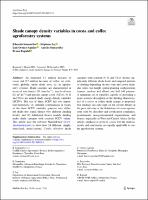| dc.contributor.author | Somarriba, Eduardo | |
| dc.contributor.author | Saj, Stephane | |
| dc.contributor.author | Orozco‑Aguilar, Luis | |
| dc.contributor.author | Somarriba, Aurelio | |
| dc.contributor.author | Rapidel, Bruno | |
| dc.date.accessioned | 2024-01-08T16:24:12Z | |
| dc.date.available | 2024-01-08T16:24:12Z | |
| dc.date.issued | 2023-12-18 | |
| dc.identifier.uri | https://repositorio.catie.ac.cr/handle/11554/12608 | |
| dc.description.abstract | An estimated 3.4 million hectares of cocoa and 9.7 million hectares of coffee are cultivated, globally, under shade trees, i.e. in agroforestry systems. Shade canopies are characterized in terms of tree density (N, trees ha−1), tree basal area (G, m2ha−1) and percent canopy cover (%Cov). N, G and %Cov are named shade canopy density variables (SCDV). The use of these SCDV has two important limitations: (1) different combinations of values of the three SCDV variables generate very different shade tree stands (hence very different shading levels), and (2) Additional factors modify shading under shade canopies with constant SCDV values.This article uses the software ShadeMotion (www.shade motion. net) to show how 24 different, simple, even-sized, mono-layered, Cordia alliodora shade canopies with constant N, G and %Cov display significantly different shade levels and temporal patterns of shading depending on tree stem and crown diameter ratios, tree height, spatial planting configurations (square, random and alleys) and leaf fall patterns. A minimum set of variables capable of providing a more accurate description of the shading characteristics of a cocoa or coffee shade canopy is proposed. Our findings can shed light on the current debate on the pros and cons of the definitions of cocoa agroforestry used by chocolate and certification companies, governments, non-governmental organizations, and donors, especially in West and Central Africa. In this article, emphasis is given to cocoa, but the analysis, results and conclusions are equally applicable to coffee agroforestry systems. | es_ES |
| dc.format.extent | 17 páginas | es_ES |
| dc.language.iso | en | es_ES |
| dc.publisher | Springer Nature | es_ES |
| dc.relation.ispartof | Agroforestry Systems | es_ES |
| dc.relation.uri | https://doi.org/10.1007/s10457-023-00931-2 | es_ES |
| dc.subject | Árboles de sombra||shade trees||árvore de sombra||arbre d'ombrage | es_ES |
| dc.subject | Cordia alliodora||Cordia alliodora||Cordia alliodora||Cordia alliodora | es_ES |
| dc.subject | área basal||basal area||área basal||surface terrière | es_ES |
| dc.subject | Cubierta de copas||canopy||coberto arbóreo ou arbustivo||couvert | es_ES |
| dc.subject | Shade tree density | es_ES |
| dc.subject | Spatial planting patterns | es_ES |
| dc.subject | Monthly leaf fall pattern | es_ES |
| dc.subject.other | Sede Central | es_ES |
| dc.title | Shade canopy density variables in cocoa and coffee agroforestry systems | es_ES |
| dc.type | Artículo | es_ES |
| dc.creator.id | https://orcid.org/0000-0002-9371-9799 | es_ES |
| dc.creator.id | https://orcid.org/0000-0001-5856-5459 | es_ES |
| dc.creator.id | https://orcid.org/0000-0002-2731-3563 | es_ES |
| dc.creator.id | https://orcid.org/0000-0003-0288-5650 | es_ES |
| dc.identifier.status | restrictedAccess | es_ES |
| dc.subject.sdg | ODS 15 - Vida de ecosistemas terrestres | es_ES |


